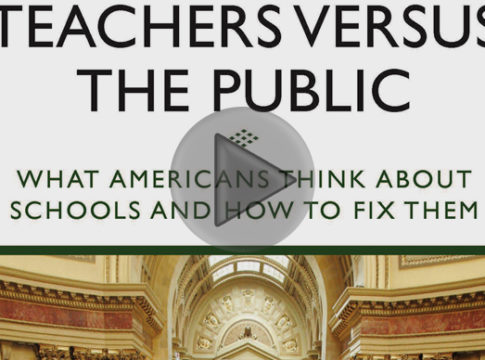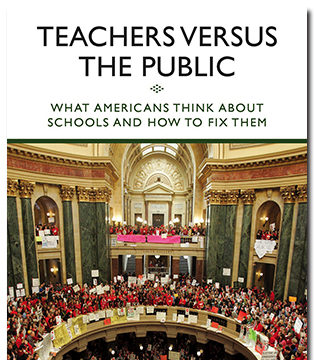 Teachers Versus the Public: What Americans think about schools and how to fix them
Teachers Versus the Public: What Americans think about schools and how to fix them
by Paul E. Peterson, Michael Henderson, and Martin R. West
Brookings Institution Press, 2014, $28.00; 144 pages.
As reviewed by David Steiner
Most Americans possess only general, and not quite accurate, notions about their public schools. Moreover, the perceptions of the general public and the teaching profession often differ quite dramatically.
Paul Peterson (well known to readers of Education Next as its editor in chief), director of the Program on Education Policy and Governance and professor at Harvard University, and his fellow authors have published a short book that quantifies this reality. They find that Americans typically overestimate local school performance and underestimate costs and salaries. More than 80 percent of the public support annual student testing, three-quarters favor charter schools, two-thirds favor higher teacher pay, and half are in favor of means-tested vouchers. In contrast to the general public, teachers are less likely to support school choice, testing, and school accountability, and more likely to support higher teacher salaries and raising taxes to pay for them.
These findings are less than surprising, and some of them are familiar. It has long been known that Americans are locally generous to education performance, meaning that they inflate the academic performance of their own children and their own children’s schools. On the latter point, Gallup polling between 2007 and 2012 indicates that about 50 percent of respondents gave a grade of A or B to the schools in their community, while only 20 percent gave those grades to the nation’s schools as a whole. The Peterson results track the Gallup poll results quite closely, with 44 percent of the respondents giving their local schools one of the top two grades and 20 percent giving those grades nationally.
So what’s the news in the research this book reports? Two findings are noteworthy. First, provided with more precise information about the performance of their schools and districts, Americans lower their ratings of local schools and express greater support for charter schools, parent trigger mechanisms, and vouchers (if extended to all children). These views are especially prevalent among Americans who live in low-performing school districts. Give them information about teacher salaries, and Americans become more skeptical about supporting increases in teacher pay.
The second set of findings regards differences between African American and white opinions. There is relative silence, unfortunately, on Hispanic views. The text notes, without any further analysis, that Hispanics rate their schools far more highly than do African Americans, but why? Focusing on African Americans, the authors report that they are (understandably) far more critical of their schools than the rest of the public, and far more supportive of what is repeatedly called “the reform agenda”: merit pay for teachers, charter schools, vouchers, and tax credits to fund private school scholarships. On all of these issues, the gap in opinion between African Americans and teachers is especially marked.
It seems clear that Peterson and his colleagues are not simply reporting these findings for their own sake; a political agenda gradually takes shape in these pages. First, they hint that disseminating real data about school performance and teacher salaries would lead to more rapid reform. (In this context, the authors hold out hope that assessment results based on Common Core standards will increase transparency of educational achievement across the country, a bet that looks less secure than it did a year ago.)
Second, Peterson and his coauthors see an opening in the split between African Americans and teachers unions. The authors note the wealth of teachers unions and the role that their dollars play in keeping the national civil-rights leadership in line with union priorities—against the wishes of most black citizens. But, they argue, African Americans’ growing awareness of the failings of public schools and their enthusiasm for alternatives are putting pressure on the status quo: “The alliance between teachers and minorities within the Democratic coalition can be held together as long as education problems are defined as the by-product of inadequate funding. While successful in the past, today that strategy is becoming problematic…”
The authors tiptoe in these intimations; they do not stride. There is nothing concrete on political strategies. Only occasionally does the tone change. Drawing on comparisons to the airline and communications industries, the authors in their closing pages advocate for “large-scale competition” in the education sector. Their argument: “If large-scale competition is introduced, the government will not need to persuade teachers to go along with reforms, as teachers will be struggling to keep their jobs if students move elsewhere.” But while the call for competition is clear, the strategies to encourage it are not laid out.
What to make of the book? One could certainly quibble with small points. For instance, the authors refer to “the reform” case as though it were monolithic and uncontested, and cite, for example, arguments that certified teachers are no more effective than uncertified, with no indication that this finding is disputed in the literature. Throughout, one might wish that the authors were less coy about the agenda they can see taking shape around their findings.
But for this reviewer, the deeper issue lies elsewhere: the authors’ narrow range of “reform” opportunities. When parents know their children are getting a disastrously poor education, it is unsurprising that they will support alternatives, especially if those alternatives have shown powerful results, as, say, is the case in some New York City charter schools. But there is a certain begging the question in the authors’ reserving of the term “reform” for only the set of policies endorsed by such bodies as Democrats for Education Reform, the U.S. Department of Education and sympathetic state school chiefs, and certain figures, such as Jeb Bush, in the Republican Party.
The survey and the book would have been more provocative had a much broader “reform” agenda been considered, one that proposes rethinking teacher preparation, reshaping the tax structure, or establishing a national curriculum, for instance. Other countries, such as Finland, closed their schools of education and moved them to the universities, requiring subject-matter degrees and raising the bar for entry substantially. Ontario, too, focused its efforts on strong teacher preparation. Alberta, Canada, overhauled its property-tax structure to distribute resources more equitably, and at the same time expanded funding for school choice (including home-school stipends). Still other countries, such as England, are moving toward content-rich curricula, since academic rigor is shown to diminish the achievement gap as few other interventions do. Peterson’s team did not explore any of these reform options.
The authors would naturally respond that such alternatives aren’t seriously on the radar screen. That, of course, is the point. The policymakers in Washington who define “reform” delimit the realm of imaginable alternatives. How would the general public in the United States respond if given an educated choice between the reform agendas in Ontario and Washington? That’s what we need to know.
David Steiner is dean of the School of Education at Hunter College.
This article appeared in the Fall 2014 issue of Education Next. Suggested citation format:
Steiner, D. (2014). Reporting Opinion, Shaping an Agenda: Have reformers considered all the options? Education Next, 14(4), 83-84.





